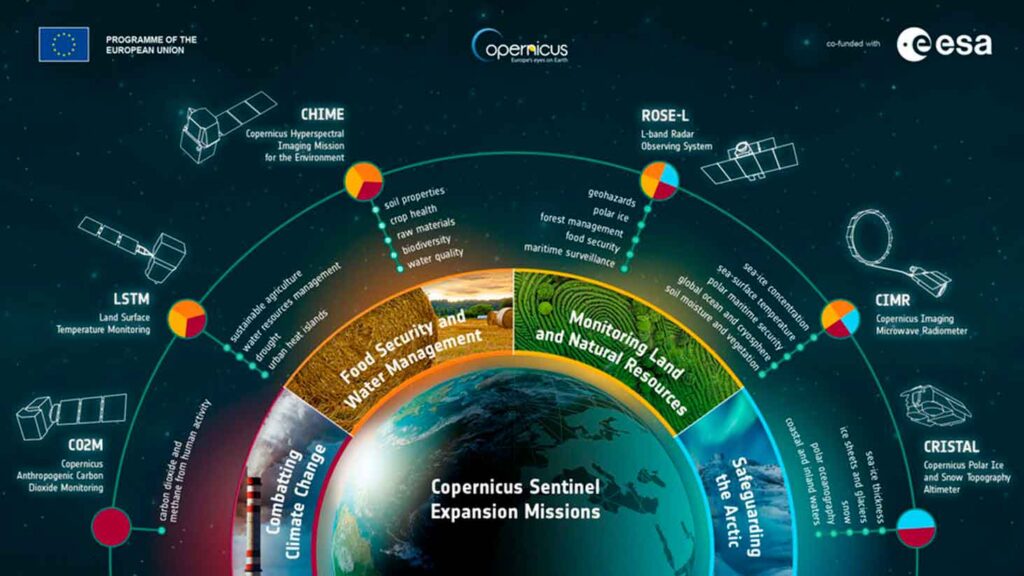- Sectors
- Aerospace & Defense
- Big science
- Fintech
- Insights

The ambitious Copernicus space program is a European project that began its journey in the nineties. It is a constellation of Earth observation satellites and a global network of ground stations that work together to collect a wide variety of data and images about the Earth’s surface, atmosphere, oceans and ecosystems.
These data are used to monitor and analyze different environmental aspects, such as air quality, vegetation cover, ocean temperature, pollution levels and changes in ice cover, among others. In practice, the monitoring of these phenomena has contributed to natural disaster management and emergency response.
Copernicus began in 1998 with the launch of the first satellite of the ERS (European Remote Sensing) series, ERS-1, by the European Space Agency (ESA). However, the program in its current form was officially established by the European Commission in 2014, when the first satellite of the Sentinel series was launched. This ambitious program is now in its 25th year of providing accurate, up-to-date and easily accessible information to improve environmental management, understand and mitigate the effects of climate change and ensure public safety.
Behind this initiative, and together with leading technology companies, is ARQUIMEA, a leading company in the design and manufacture of optical systems, deployable systems, avionics and space-qualified microchips. In addition, ARQUIMEA has recently added to its portfolio the experience of Iberespacio, a company specialized in the design and manufacture of thermal structures and systems that has successfully completed more than 90 space missions. We have demonstrated our experience and capacity to face the challenges of space by providing technologies in 19 of the 21 Copernicus missions.
At ARQUIMEA we have state-of-the-art facilities covering more than 5,000m2 of clean rooms and manufacturing areas dedicated to the creation and integration of systems for satellites. This state-of-the-art production capacity has allowed us to participate in 19 Copernicus missions, both in satellites and scientific instruments. In these missions we have played a relevant role in the European space industry with the manufacture of structures and thermal systems, as well as mechanisms and actuators for the retention and release (HDRM) of payloads.
The thermal control systems for satellites have the objective of maintaining the entire structure and the equipment it houses within the temperature parameters specified at each moment of the mission. This process is critical for the correct operation of the satellite and its useful life.
ARQUIMEA has more than a decade of experience in the design, manufacturing and testing of thermal structures, systems and thermal hardware used in the most relevant international space missions. With more than 90 successful missions and more than 2,200 units launched among thermal subassemblies, thermo-structural panels, loop heat pipes, heat pipes, deployable radiators and thermal blankets.
One of the highlights of our products for the space sector are non-pyrotechnic hold and release mechanisms (HDRM) based on shape memory technology (SMA). These mechanisms allow their integration and testing on the satellite on the ground, guaranteeing their correct functioning once deployed in space.
This is a major advantage over traditional pyrotechnic systems. In addition, these mechanisms have the capacity to withstand high pressures and extreme temperatures ranging from -90 to +125 degrees Celsius and are responsible for securing the payload during launch and deploying it once the satellite is in orbit.
The Sentinel satellites are a series of Earth observation satellites developed by the European Space Agency (ESA) in collaboration with the European Union (EU) as part of the Copernicus program. Each Sentinel satellite has a specific function and capability to collect data about our planet from space. There are six types of Sentinel satellites and ARQUIMEA is present in five of these six varieties.

ARQUIMEA has a team of professionals made up of more than 200 specialists including doctors, engineers and technicians, as well as state-of-the-art facilities for the integration of satellite systems.
Specifically, ARQUIMEA has provided Copernicus with a thermal structure, twelve thermal subsystems, 20 loop heat pipes, more than 250 heat pipes and several units of HDRM mechanisms.
Our main lines of activity for the space sector include the design and manufacture of structures, thermal systems, optical systems, deployable systems, avionics and space-qualified microchips. However, Copernicus is not the only reference space mission in which we participate. Our customers include international space agencies such as NASA and ESA and major space companies. We are currently leading the development of a constellation of 250 telecommunications satellites based on our own platform for the BeetleSat project, which will provide secure global connectivity in the coming years.